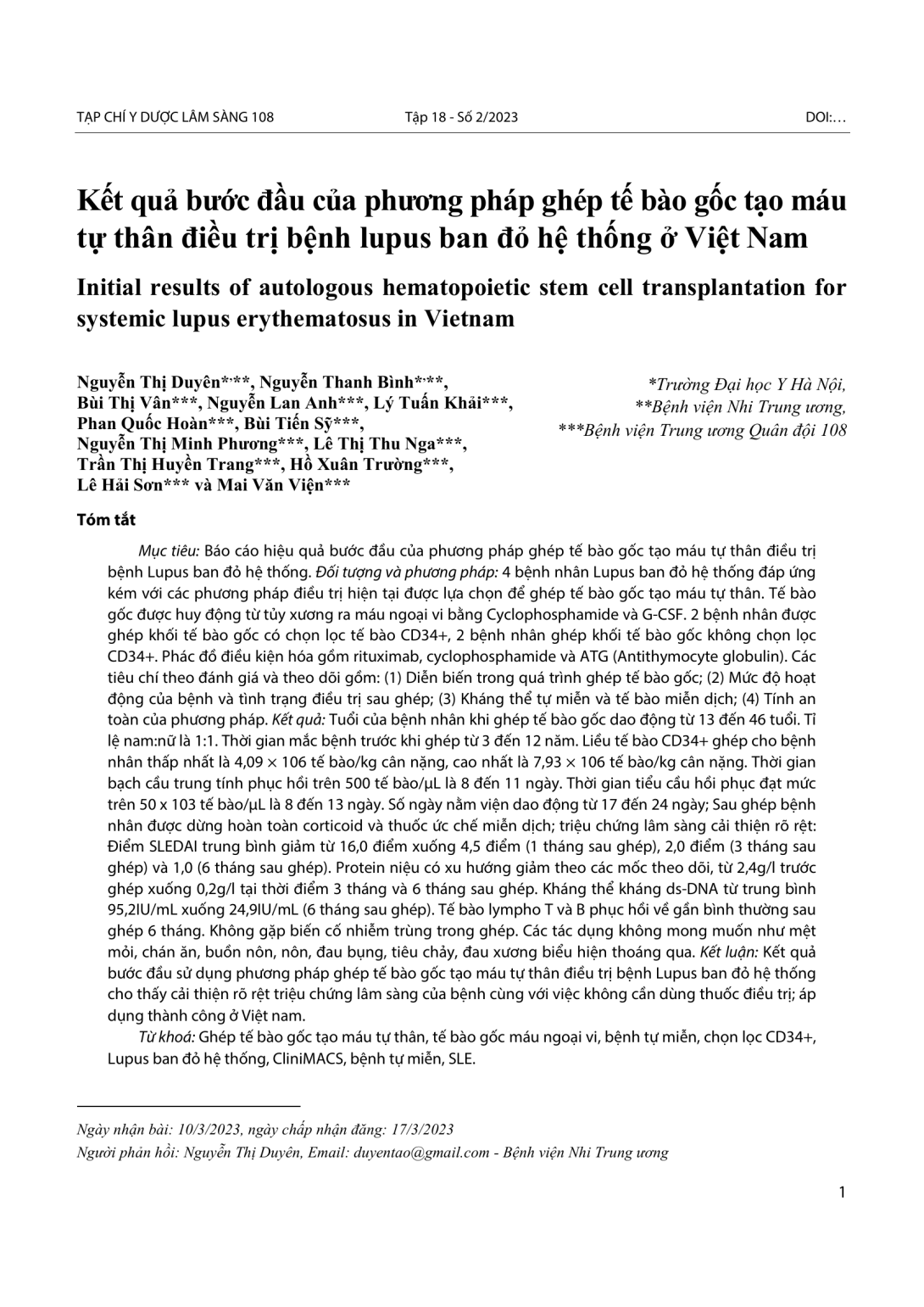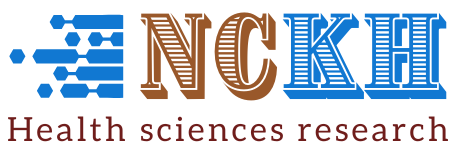
Báo cáo hiệu quả bước đầu của phương pháp ghép tế bào gốc tạo máu tự thân điều trị bệnh Lupus ban đỏ hệ thống. Đối tượng và phương pháp: 4 bệnh nhân Lupus ban đỏ hệ thống đáp ứng kém với các phương pháp điều trị hiện tại được lựa chọn để ghép tế bào gốc tạo máu tự thân. Tế bào gốc được huy động từ tủy xương ra máu ngoại vi bằng Cyclophosphamide và G-CSF. 2 bệnh nhân được ghép khối tế bào gốc có chọn lọc tế bào CD34+, 2 bệnh nhân ghép khối tế bào gốc không chọn lọc CD34+. Phác đồ điều kiện hóa gồm rituximab, cyclophosphamide và ATG (Antithymocyte globulin). Các tiêu chí theo đánh giá và theo dõi gồm: (1) Diễn biến trong quá trình ghép tế bào gốc; (2) Mức độ hoạt động của bệnh và tình trạng điều trị sau ghép; (3) Kháng thể tự miễn và tế bào miễn dịch; (4) Tính an toàn của phương pháp. Kết quả: Tuổi của bệnh nhân khi ghép tế bào gốc dao động từ 13 đến 46 tuổi. Tỉ lệ nam:nữ là 1:1. Thời gian mắc bệnh trước khi ghép từ 3 đến 12 năm. Liều tế bào CD34+ ghép cho bệnh nhân thấp nhất là 4,09 × 106 tế bào/kg cân nặng, cao nhất là 7,93 × 106 tế bào/kg cân nặng. Thời gian bạch cầu trung tính phục hồi trên 500 tế bào/μL là 8 đến 11 ngày. Thời gian tiểu cầu hồi phục đạt mức trên 50 x 103 tế bào/μL là 8 đến 13 ngày. Số ngày nằm viện dao động từ 17 đến 24 ngày; Sau ghép bệnh nhân được dừng hoàn toàn corticoid và thuốc ức chế miễn dịch; triệu chứng lâm sàng cải thiện rõ rệt: Điểm SLEDAI trung bình giảm từ 16,0 điểm xuống 4,5 điểm (1 tháng sau ghép), 2,0 điểm (3 tháng sau ghép) và 1,0 (6 tháng sau ghép). Protein niệu có xu hướng giảm theo các mốc theo dõi, từ 2,4g/l trước ghép xuống 0,2g/l tại thời điểm 3 tháng và 6 tháng sau ghép. Kháng thể kháng ds-DNA từ trung bình 95,2IU/mL xuống 24,9IU/mL (6 tháng sau ghép). Tế bào lympho T và B phục hồi về gần bình thường sau ghép 6 tháng. Không gặp biến cố nhiễm trùng trong ghép. Các tác dụng không mong muốn như mệt mỏi, chán ăn, buồn nôn, nôn, đau bụng, tiêu chảy, đau xương biểu hiện thoáng qua. Kết luận: Kết quả bước đầu sử dụng phương pháp ghép tế bào gốc tạo máu tự thân điều trị bệnh Lupus ban đỏ hệ thống cho thấy cải thiện rõ rệt triệu chứng lâm sàng của bệnh cùng với việc không cần dùng thuốc điều trị; áp dụng thành công ở Việt nam.
To report the initial efficacy of autologous hematopoietic stem cell transplantation (HSCT) in treatment of systemic lupus erythematosus. Subject and method: Four patients with systemic lupus erythematosus who responded poorly to conventional treatments were selected for autologous hematopoietic stem cell transplantation. Stem cells were mobilized from bone marrow to peripheral blood by Cyclophosphamide and G-CSF. Two patients received a transplant of CD34+ selective stem cells, while 2 other patients received a transplant of CD34+ non-selective stem cells. The conditioning protocol includes Rituximab, Cyclophosphamide and ATG (anti-thymocyte globulin). Evaluation and monitoring criteria include (1) Stem cell transplantation progress; (2) Disease activity level and posttransplant therapy status; (3) Autoimmune antibodies and immune cells; (4) The method's safety. Results: The age of patients at the time of HSCT ranged from 13 to 46 years. The male:female ratio is 1:1. Disease duration before transplantation was from 3 to 12 years. The lowest dose of CD34+ cells for transplantation was 4.09 × 106 cells/kg body weight, the highest was 7.93 × 106 cells/kg body weight. The recovery time for neutrophils above 500 cells/μL is 8 to 11 days. The time it takes for platelets to recover to levels above 50 × 103 cells/μL is 8 to 13 days. Hospital stay for HSCT ranges from 17 to 24 days; After transplantation, all corticosteroids and immunosuppressive drugs were discontinued; Clinical symptoms significantly improved (mean SLEDAI score decreased from 16.0 points to 4.5 points (1 month after transplant), 2.0 points (3 months after transplant), and 1.0 points (6 months after transplant). Proteinuria decrease as time passed, from 2.4g/l before transplant to 0.2g/l three and six months after transplant. Anti-dsDNA antibodies concentrations decreased from 95.2IU/mL on average to 24.9IU/mL (6 months post-transplant). Six months following HSCT, T lymphocytes, and B lymphocytes returned to near-normal levels. No infectious incidents occurred during the transplant. Fatigue, anorexia, nausea, vomiting, abdominal pain, diarrhea, and bone pain are temporary side effects. Conclusion: Initial results using autologous hematopoietic stem cell transplantation for systemic lupus erythematosus showed a marked improvement in clinical symptoms of the disease along with no need for medication; successfully applied in Vietnam.
- Đăng nhập để gửi ý kiến
